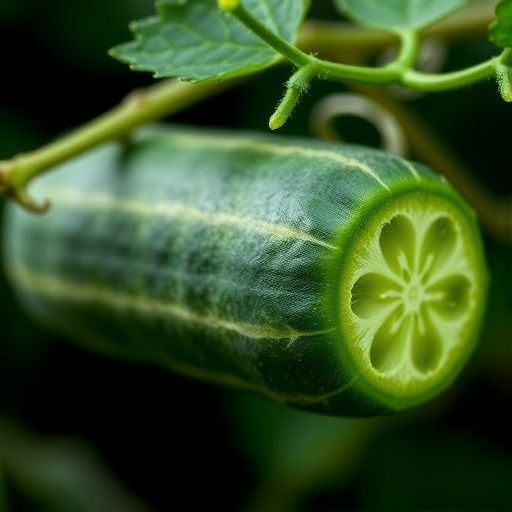In the ever-evolving world of agricultural biotechnology, researchers are unlocking the secrets of fruit morphology, particularly in cucumbers. A recent groundbreaking study conducted by Zhou, Liu, and Chen revealed astounding details about the formation of hollow fruits in cucumbers through the use of RNA sequencing and histological analysis. This revelation not only holds potential implications for cucumber cultivation but also offers vital insights into genetic expressions that dictate morphological traits in plants. Hollow fruits have been a curious anomaly in cucumber production, presenting both a challenge to growers and an opportunity for scientific investigation.
The study meticulously examines the genetic underpinning of hollow fruit formation, offering a new perspective on how environmental and genetic factors converge to influence fruit development. Cucumber, or Cucumis sativus, is a widely cultivated crop that relies heavily on genetic traits for yield and quality. The formation of hollow fruits, which can lead to reduced market value and consumer acceptance, shows how this genetic trait can negatively impact agricultural productivity. The research team embarked on this study to dissect the molecular reasons behind this phenomenon.
To delve deeper, the researchers employed RNA sequencing—a technique that allows for the comprehensive examination of the transcriptome, the complete set of RNA transcripts produced by the genome under specific circumstances. By analyzing the expression patterns of various genes in hollow fruits compared to solid counterparts, they were able to identify specific genes that are upregulated or downregulated during the fruit development stages. This detailed gene expression analysis serves as a roadmap to understanding the complex biological processes that result in hollow fruit formation.
Histological analysis complemented the RNA sequencing by providing a microscopic perspective on the anatomical differences between hollow and non-hollow cucumbers. This approach revealed significant differences in fruit cell structure, particularly in the fruit skin and internal mesophyll tissues, which have direct implications for fruit strength and integrity. Cytological examinations showed that the hollowness correlates with alterations in cell wall composition and density, leading to an inability for the fruit to develop the necessary structural integrity.
The discovery of genetic markers associated with hollow fruit formation is particularly exciting. Such markers can potentially be utilized in selective breeding programs, enabling breeders to emphasize desirable traits while mitigating the incidence of hollowness in cucumbers. This could revolutionize cucumber cultivation, leading to increased yields and improved quality in the marketplace. Understanding the molecular genetics behind fruit structure also helps broaden the scope of research into other crops where similar issues may arise, thereby impacting food security on a more global scale.
Moreover, this study takes the idea of “precision agriculture” to the next level. By integrating genetic insights with traditional agricultural practices, farmers could apply this knowledge to better manage crop varieties that are more resilient or yield higher-quality fruits. As the global demand for cucumbers continues to rise, ensuring consistent quality and reducing waste due to hollow fruits represents a major step forward in meeting consumer expectations and sustaining agricultural livelihoods.
The research has also sparked interest among scientists investigating analogous morphological mutations in other fruit-bearing plants. Given the variety of factors influencing fruit structure, this study can serve as a model for examining genetic traits across a wide array of species. Should the findings about cucumbers extend to tomatoes, peppers, or squash, the implications could be profound, presenting an opportunity to utilize genetic insights across various fruits and potentially transforming agricultural practices.
Furthermore, the implications of this research extend beyond agriculture. The understanding of cellular mechanisms at play during fruit development can have direct applications in food sciences. It paves the way for tailoring the textural and nutritional characteristics of fruits, leading to innovations that can enhance the sensory experience for consumers and improve health benefits. The intersection of genetic research and food technology marks a new frontier in our approach to understanding and modifying plant traits.
In conclusion, the findings of Zhou, Liu, and Chen not only unravel the mystery behind hollow fruits in cucumbers but also herald a shift in agricultural practices grounded in genetic science. By bridging the gap between genetic understanding and practical application, this study opens up new pathways for ensuring food security and developing crops that meet evolving consumer demands. The insights gained from this research are not just relevant to cucumbers; they represent a template for investigating the complexities of fruit morphology within the vast landscape of agricultural biotechnology.
As the study emerges in BMC Genomics, the academic community eagerly anticipates further discourse regarding these discoveries. The resulting dialogue among agronomists, geneticists, and food technologists will likely lean towards collaborative efforts aimed at enhancing crop traits. Future investigations may focus on the mechanistic pathways leading to hollow fruit formation, providing even greater clarity for stakeholders in the agricultural sector.
The trajectory of this research illustrates the power of modern techniques such as RNA sequencing and histology to illuminate long-standing agricultural challenges. As researchers continue to probe the genetic fabric of plants, we can expect more revelations that will shape the future of agriculture. This continuous cycle of discovery and innovation underscores the ever-important role of science in addressing global food challenges.
The implications of this groundbreaking research extend well beyond cucumbers. Insights gained from RNA sequencing and histological analysis can guide efforts in horticulture, conservation, and biotechnological applications, enriching our understanding of the fundamental principles governing plant development. With ongoing advancements in genetic engineering and genomic technologies, the agricultural landscape may soon see practical solutions that marry science and farming for a sustainable future.
Subject of Research: Genetic basis of hollow fruit formation in cucumbers
Article Title: RNA sequencing and histology analysis provide insights into the formation of hollow fruits in cucumber.
Article References:
Zhou, G., Liu, X., Chen, H. et al. RNA sequencing and histology analysis provide insights into the formation of hollow fruits in cucumber.
BMC Genomics 26, 1063 (2025). https://doi.org/10.1186/s12864-025-12253-x
Image Credits: AI Generated
DOI: https://doi.org/10.1186/s12864-025-12253-x
Keywords: Cucumber, hollow fruits, RNA sequencing, histology, fruit development, agricultural biotechnology.




